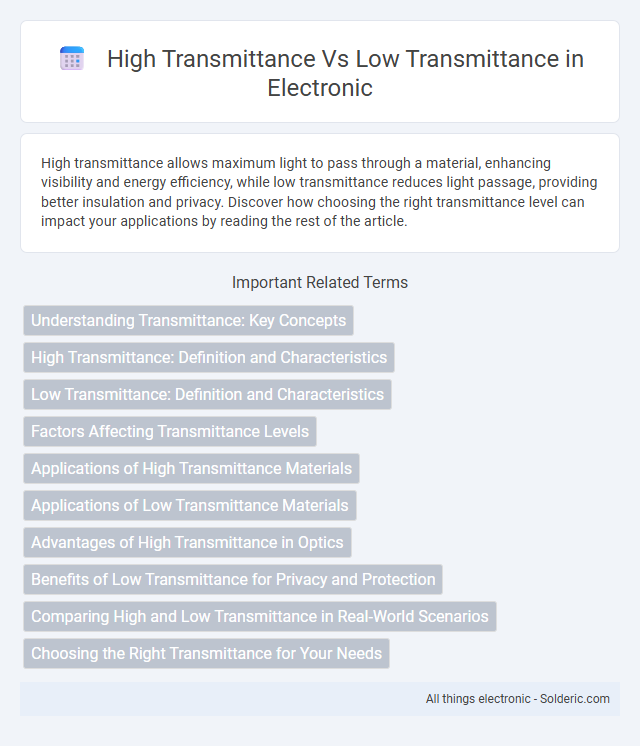High transmittance allows maximum light to pass through a material, enhancing visibility and energy efficiency, while low transmittance reduces light passage, providing better insulation and privacy. Discover how choosing the right transmittance level can impact your applications by reading the rest of the article.
Comparison Table
| Feature | High Transmittance | Low Transmittance |
|---|---|---|
| Definition | Allows a high percentage of light to pass through | Allows a low percentage of light to pass through |
| Light Transmission Rate | Typically above 70% | Typically below 30% |
| Applications | Windows, solar panels, eyewear lenses | Privacy glass, sunglasses, shading films |
| Energy Efficiency | Maximizes natural light, reduces artificial lighting | Minimizes glare and heat gain, enhances cooling |
| Privacy | Low privacy, clear visibility | High privacy, obscured visibility |
| Heat Transmission | Higher heat transfer, can increase indoor temperature | Lower heat transfer, better for insulation |
| Cost | Generally lower cost | Usually higher cost due to special coatings |
Understanding Transmittance: Key Concepts
Transmittance measures the proportion of light or radiation passing through a material, directly influencing visibility and energy efficiency in applications such as windows and solar panels. High transmittance materials allow more light to transmit, enhancing brightness and clarity, while low transmittance materials reduce light passage, improving insulation and glare control. Understanding the interaction between wavelength, material composition, and surface texture is essential for optimizing transmittance properties in desired applications.
High Transmittance: Definition and Characteristics
High transmittance refers to the property of a material or surface that allows a large percentage of incident light or radiation to pass through it, typically measured as a high transmittance coefficient or percentage. Materials with high transmittance, such as clear glass or certain plastics, exhibit minimal absorption and reflection, resulting in maximum light penetration and clarity. Key characteristics include low haze, high clarity, and the ability to maintain the intensity and quality of transmitted light for applications in optics, solar energy, and display technologies.
Low Transmittance: Definition and Characteristics
Low transmittance refers to the property of a material or surface that allows only a small percentage of light or radiation to pass through it. Materials with low transmittance typically have higher absorption or reflection rates, making them effective for applications requiring light blocking or privacy. Your choice of low transmittance materials can enhance energy efficiency by reducing heat transfer and glare in buildings or devices.
Factors Affecting Transmittance Levels
Transmittance levels are primarily influenced by material properties such as thickness, surface texture, and chemical composition, where thicker or more opaque materials typically exhibit lower transmittance. Environmental conditions like temperature, wavelength of incident light, and angle of incidence also play critical roles in determining whether a material exhibits high or low transmittance. Factors including impurities, surface reflections, and internal scattering further impact the efficiency of light passing through a medium.
Applications of High Transmittance Materials
High transmittance materials allow a significant amount of light to pass through, making them ideal for applications such as solar panels, optical lenses, and display screens where clarity and light efficiency are crucial. In contrast to low transmittance materials, these high transmittance substances enhance energy efficiency, improve image quality, and maximize brightness in various devices. Your projects benefit from choosing materials with high transmittance to ensure optimal light transmission and performance.
Applications of Low Transmittance Materials
Low transmittance materials are widely used in applications requiring minimal light or radiation passage, such as protective eyewear, solar control windows, and radiation shielding in medical and industrial environments. Their ability to block or absorb significant portions of visible and ultraviolet light makes them essential for reducing glare, enhancing privacy, and improving energy efficiency. These materials also play critical roles in optical filters, display technologies, and greenhouse panels to manage light exposure effectively.
Advantages of High Transmittance in Optics
High transmittance in optics ensures maximum light passage through lenses or materials, enhancing image clarity and brightness crucial for precision applications such as microscopy and photography. Your optical systems benefit from reduced energy loss and improved efficiency, allowing for better performance in low-light conditions. High transmittance materials also minimize heat buildup, preserving the integrity and longevity of optical components.
Benefits of Low Transmittance for Privacy and Protection
Low transmittance materials effectively reduce light and visibility passing through surfaces, enhancing privacy by limiting external view into your space. They offer superior protection from harmful UV rays and glare, which helps in maintaining indoor comfort and protecting furnishings from fading. Utilizing low transmittance solutions improves energy efficiency by reducing heat gain, thus lowering cooling costs and contributing to a safer, more private environment.
Comparing High and Low Transmittance in Real-World Scenarios
High transmittance materials allow a greater percentage of light to pass through, making them ideal for applications such as solar panels and greenhouse glazing where maximum light exposure is crucial. Low transmittance materials reduce light transmission, which benefits energy-efficient windows and privacy glass by minimizing heat gain and glare. Understanding your specific needs in lighting, energy efficiency, and privacy helps determine whether high or low transmittance is best suited for your scenario.
Choosing the Right Transmittance for Your Needs
High transmittance materials allow maximum light to pass through, making them ideal for applications requiring clear visibility, such as solar panels and optical lenses. Low transmittance materials reduce light penetration, enhancing privacy and controlling glare in windows and sunglasses. You should select the transmittance level based on your specific requirements for light control, energy efficiency, and visual comfort.
High Transmittance vs Low Transmittance Infographic

 solderic.com
solderic.com